
Today, everyone already knows what lubricants are and how to use them. However, despite the widespread awareness of this product, few people are aware of the dangerous ingredients in their composition that can cause infections, irritation, and increased susceptibility to STIs [1] [6-13].
A good lubricant is a physiological lubricant.
This comprehensive guide will help you once and for all understand how to choose a safe lubricant for yourself. We will explain how science works in the field of intimate lubricants and also which lubricants you should never use.
No marketing or advertising, just science and the perspective of an expert who knows everything about lubricants and more. Want to become an expert? Let's go.

A survey of 1021 women found that 20% used a lubricant in the past 30 days, and 65.5% had used it at least once in their life [3]. A similar study showed that 25% of men used a lubricant in the past 30 days, and 70% had used it at least once in their life [4].
No such studies have been conducted in Russia, Belarus, and Ukraine.
So, who uses lubricants:
Women in menopause
Pregnant women
Women after childbirth
Women after surgeries, chemotherapy, taking antibiotics, hormonal medications, birth control pills
Men and women during anal sex
Men and women during masturbation
Men and women during toy play
Men and women during vaginal sex to reduce discomfort and pain
Women to alleviate symptoms of vaginal dryness

There are four main types of lubricants: water-based, oil-based, silicone-based, and hybrid. Each type corresponds to its own base (the main component): water, vegetable oil, silicone, and hybrid (a combination of several bases). Other ingredients are added to the base to change viscosity, pH, extend shelf life, enhance moisturizing effects, enrich with soothing and healing substances, add fragrance, or provide cooling or warming effects.

Meet the water-based lubricant. The most popular and versatile, accounting for 72.5% of all sales in 2015 [5].
This lubricant is 95% water. It should provide the feeling of natural vaginal lubrication. Other ingredients are added to the water base to make the texture gel-like. Often, moisturizing agents (hyaluronic acid, aloe vera, etc.) and pH regulators (citric acid, lactic acid, etc.) are used. Water-based lubricants can be either naturally or synthetically derived.
Despite their popularity and versatility, not all water-based lubricants are equally good. The composition of water-based lubricants often contains very controversial ingredients. Almost all water-based lubricants use components such as glycerin, propylene glycol, or preservatives like parabens (despite what they say, they have a cumulative effect), chlorohydrate, phenoxyethanol, which, as recent studies show, can damage vaginal and anal tissues, leading to an increased risk of infections, STIs, and irritation.
If glycerin is second on the ingredient list, it means there is too much of it for your vagina to stay healthy.
Many companies use the traditional method of adding glycerin or propylene glycol because it is cheap and provides good slip. However, there are healthier alternatives: seaweed extract, carob gum, guar gum, or xanthan gum.
If you suffer from vaginal dryness, water-based lubricants may be a good choice. Their composition often includes ingredients that moisturize the mucous membrane. Look for ingredients like: aloe vera, hyaluronic acid, guar gum, squalane (found in natural plant oils), and other moisturizers – these ingredients will help you combat vaginal dryness symptoms.
Choose a lubricant with a light gel texture, as it creates the feeling of natural moisture.
Water-based lubricants are more physiological. However, only those that, tarram-pam.. consider physiology! pH in the range of 3.5–4.3, osmolality not higher than 380 mOsm/kg, ingredients that do not damage or irritate cells. Unfortunately, there aren't many such lubricants. In our countries, no one checks or controls these indicators. It all depends on the manufacturers' integrity. You can still measure pH at home, study the composition, but osmolality is more difficult. To understand how bad it is, I suggest looking at the table published by WHO.

Use and purchase of additional lubricants for male and female condoms: WHO / UNFPA / FHI360
The pH of the vagina and anus are different. Anal lubricants are not suitable for vaginal sex and vice versa.
Water-based lubricants are suitable for all types of sex toys and condoms.
A special topic – edible lubricants. Sugar, synthetic sugar substitutes, glycerin, propylene glycol, sorbitol, synthetic flavorings. These are far from the best ingredients for the vagina. Sugar leads to yeast infections. Fragrances are among the top twenty strongest allergens and irritate the skin. They say, "Eat it yourself." "Fun play" actually turns into a heavy burden for the body.
Advantages:
Cheap
Water-soluble, easy to wash off
Resembles natural vaginal lubrication
Disadvantages:
Some may contain harmful ingredients
Evaporates quickly and requires frequent reapplication.

The family of lubricants with truly super-slippery properties.
Unlike water, silicone ingredients do not evaporate or absorb into the skin. The result is a lubricant that keeps sliding and sliding.
Silicone lubricant is inert, non-toxic, and hypoallergenic. Silicone does not require preservatives and does not damage delicate tissues [6].
However, silicone is difficult to wash off with water. It coats the skin with a film, preventing moisture from evaporating. If used for vaginal sex, keep in mind that silicone-based lubricant will stay inside you for some time. However, silicone-based lubricants can be used in the shower, as they won’t wash away with water. They are compatible with all types of condoms. By the way, almost all condoms are coated with silicone during manufacturing.
Silicone lubricant has another dark side. It hates silicone, the popular and expensive material used for sex toys. I don’t know why, but as soon as silicone lubricant interacts with silicone toys, deformation and distortion of the toy occur. You've been warned, keep these friends apart.
As an "eco friend," I can't help but mention that silicone is also a synthetic polymer, which is non-biodegradable. After you wash it off, it will sit in the water for many years. Silicone lubricants do not have a moisturizing effect and do not affect the mucous membrane (they don’t work on it), so if you need moisture, this is not silicone.
Advantages:
Super long-lasting glide effect
Hypoallergenic, inert, and non-toxic
Odorless
Compatible with condoms
Disadvantages:
Can deform silicone sex toys
Difficult to wash off
Not "eco-friendly"
Not edible

100% natural lubricants with a long glide effect. The composition consists solely of vegetable oils: coconut oil, cocoa butter, shea butter, almond oil, grape seed oil, etc. Vegetable oils are rich in beneficial substances for the skin, including triglycerides, which mimic the natural skin sebum.
Unlike water-based lubricants, they don’t require ingredients like preservatives, thickeners, etc., making them safer.
Since they don't contain water, they don't have pH and osmolality indicators.
100% "eco-friendly" and suitable for vegans. You don’t need to wash them off, although not everyone likes the oily feeling. Oils are rich in incredible amounts of nutrients, think carefully before heading to the shower.
Oil-based lubricants are suitable for vaginal, oral, and anal sex. They are irreplaceable for masturbation and full-body erotic massage.
Oil-based lubricants can be used with silicone, wooden, steel, and glass sex toys. Oil is also suitable for water play. And, this is the only type of lubricant that can be used in water with silicone sex toys.
Beware of your sheets, oil-based lubricants can leave stains on them.
Oil-based lubricants are not compatible with latex condoms. Oil will cause latex to deform and tear easily. Oil-based lubricants work with polyurethane condoms only.
Too many misconceptions have formed around oil-based lubricants. Here are some of them.
1. Some oils are comedogenic and clog pores. Yes, this is true, but the mucous membrane of the vagina does not have pores. Over time, the oil is absorbed without staying on the tissue surface.
2. Oil cannot be used with sex toys. Yes, oil cannot be used with porous sex toys. Silicone, for example, is a non-porous material, and many tests have shown that natural oils do not damage silicone. I like to give a simple everyday example: we use silicone molds and spatulas in cooking, and in that process, they seriously interact with oils. Medical and food silicone have similar properties, the only difference is that food-grade silicone is tested for oil resistance, while medical silicone is tested for interactions with the body. Usually, this example helps people understand the essence better.
3. Vegetable oil disrupts the microflora. There is no water in oil, so no pH or osmolality indicators. These two factors contribute to the change in healthy microflora. Since these two factors are absent in oil, oil-based lubricants are perceived neutrally by the vaginal mucosa. It is known that some medical products contain lactobacilli dissolved in vegetable oil. This indicates that vegetable oil is a comfortable medium for their existence. Coconut oil has also been proven to fight “Candida” [33]. It is no wonder that organic unrefined coconut oil is widely recommended and used in its pure form as a lubricant for many years. Rapeseed oil also helps sperm move faster [34].
4. Synthetic oils and vegetable oils are the same. No, no, no. Everything written above about oil-based lubricants only applies to lubricants made from natural vegetable oils (she, coconut, almond, olive, rapeseed, etc.). Everything else – petroleum products that irritate and damage skin cells. These include: paraffin, vaseline, mineral oil.
Advantages:
Cares for the skin
100% natural
Compatible with sex toys
Glides longer than water-based lubricants
Disadvantages:
Not compatible with latex condoms
Leaves stains on your sheets.

When the composition includes water, silicone, or oil, the lubricant is hybrid.
They resemble water-based lubricants but last like silicone or oil-based lubricants. They are also easy to wash off and can be used with silicone sex toys.
This type of lubricant is still under-researched and, like water-based lubricants, may have an unhealthy composition for vaginal health.
Advantages:
Long-lasting glide
Compatible with condoms and sex toys
Disadvantages:
Too long ingredients list, may contain harmful ingredients

There are also household lubricants – lubricating substances that are not intended for intimate use but are sometimes used. I often hear: "Why do you need a lubricant if you have saliva, hand cream, or Johnson’s baby oil." I'll start by saying that Johnson’s baby oil contains no oil at all, and on the danger scale, it scores a perfect 10 out of 10. Saliva contains 200–500 microorganisms, some of which are harmful. The pH of saliva is 6.8–7.4, and the pH of the vagina is 3.5–4.3. Increasing the pH level leads to the development of pathogens. Hand creams are also not balanced in terms of the physiology of the female body. Furthermore, creams usually have complex compositions with many ingredients, which is a heavy load for vulnerable tissues.
It’s important to use safe intimate lubricants, as the vagina has a high absorption capacity.
The best household lubricants are pure coconut oil or diluted aloe vera gel. I would not recommend using anything else due to the high absorption capacity of vaginal tissue. Whatever chemicals you introduce, they can easily enter the bloodstream [18].
These rules do not apply to the penis, which is less sensitive, easily cleaned, and only has mucous membrane on the urethra. Using very acidic homemade lubricants or lubricants with harsh preservatives can cause irritation to the urethra and a burning sensation.
Safe household lubricants:
Organic coconut oil
Aloe vera gel
Avoid (dangerous for vaginal and anal tissue ):
Vaseline
Anything with sugar (honey, whipped cream, etc.)
Cosmetic gels, creams, soaps

Strange title, but the categories in the "lubricants" section of adult stores seem even stranger to me. On almost every adult store website, you can find the following categories of lubricants: arousing, penis enlarging, erection-enhancing, sensation-enhancing, cooling, prolonging, warming, for tightening the vagina, etc. I think it’s clear to everyone, from a physiological standpoint, that some of these processes are actually impossible. If you analyze what is in these lubricants, you can find harmful and irritating ingredients.
Avoid serious irritants for the vaginal mucosa: menthol, benzyl nicotinate, red pepper extract, horse chestnut extract, etc.)
Recently, lubricants like Durex Play have been thoroughly studied due to the use of petroleum-derived components and harsh preservatives [1]. In some studies, these lubricants were found to damage tissues and increase the risk of BV, yeast infections, and decrease the body's natural defense against STIs [7-13]. In light of research, the World Health Organization (WHO) made an announcement recommending people avoid using many water-based intimate lubricants available on the market [1].
To understand the controversies around water-based lubricants, it helps to know some of the science behind sex.

You don't need a degree in chemistry to choose a lubricant. However, by understanding the importance of pH, osmolality, and how they interact with your delicate skin, you’ll have a much better understanding of water-based lubricants. Believe me, only a small, insignificant percentage of gynecologists, consultants in adult stores, and bloggers writing about sex know the whole truth about lubricants. Sometimes I’m outraged by the "expert opinion" of people who simply read online articles and regurgitate "thoughts into the light."
In 2012, the World Health Organization announced that all water-based lubricants with an osmolality higher than 380 mOsm/kg are potentially dangerous to health and should be avoided [1].
Osmolality is the concentration of a solution, i.e., the amount of substance in water, excluding H2O. Using scientific instruments called osmometers, scientists can measure the osmolality of a liquid and get the value in mOsm/kg or millimoles per kilogram.
Here are some osmolality measurements of different liquids [14]:
· Pure water - 0 mOsm/kg
· Tap water - 3 mOsm/kg
· Mint tea - 184 mOsm/kg
· Cell Fluid - 285 mOsm/kg
· Blood - 290 mOsm/kg
· Semen - 380 mOsm/kg
· Fanta - 415 mOsm/kg
· Carrot juice - 561 mOsm/kg
· Red wine - 2573 mOsm/kg
· Glycerin – 14550 mOsm/kg
Cell fluid, at 280-290 mOsm/kg, is also the osmolality of vaginal and anal environments. Safe lubricants are iso-osmolar with cell fluid, meaning they are close to this range of 280-290, and as recommended by the UN, we should avoid lubricants above 380 mOsm/kg, i.e., hyperosmolar ones.

Hyperosmolar lubricants have a higher osmolality than bodily fluids, and when they meet, a reaction occurs where natural forces try to balance the water difference between the two concentrations.
This means the lubricant will draw water out of your tissues, causing cell death and dehydration. Long-term use of hyperosmolar lubricants can lead to dryness, painful irritation, BV, yeast infections, and a decreased protection against STIs [7-13]. Avoid lubricants with glycerin and propylene glycol in the composition, as these ingredients tend to have high osmolality and are typically near the top of the list in most water-based lubricants.

These lubricants have a lower osmolality than your tissue. Now the tables have turned, and your cells will draw water from the lubricants.
Hypo-osmolar lubricants are rarer than hyperosmolar ones, and only one study showed that a hypo-osmolar lubricant (Slippery Stuff) caused tissue damage in the vagina [6]. The lubricant had an osmolality of 13, about 22 times less than the osmolality of your natural lubrication. Other lubricants with osmolality three times lower than natural lubrication do not damage vaginal tissues.

These lubricants are closest to the natural osmolality level of the vagina, 285-295. When an iso-osmolar lubricant and a cell meet, they respect each other’s personal space and do not draw water from one another. Iso-osmolar lubricants are the safest. It has been proven that they not only keep the epithelial layer intact but also help restore and rejuvenate cell growth [13].
The results of some studies on the osmolality and pH of lubricants.

Osmolality of water-based lubricants
The pH scale shows how acidic a liquid is. 0 pH is the least acidic, and 14 is the most alkaline.
The vagina is naturally acidic, with a pH of 3.5 - 4.5 [15]. This acidity, created by lactobacilli producing lactic acid, maintains the vagina's cleanliness and prevents harmful bacteria and pathogens from taking control [6] [15] [16]. Vaginal lubrication should have a pH in this range of 3.5 - 4.5. If the pH is too high, the lubricant can lower the body's natural defense against infections and STIs.
The anal environment is less acidic than the vagina, with a pH of 6–7. The slight acidity acts as a buffer between the alkaline feces and the body.
Since most water-based lubricants have a pH of 4–5, some people with sores or damage may experience a burning sensation when using these lubricants. If you feel any burning during anal play, try switching to a silicone or plant-based lubricant, which has no pH level.

The vagina is very good at taking care of itself and staying clean. Vaginal fluid washes away anything that shouldn't be there, and a healthy flora produces lactic acid to kill attacking microbes. [15]
If the natural ecosystem is disturbed, the risk of infection increases. To better understand how imbalance occurs, it's helpful to learn a bit about epithelium, mucous membranes, and lactobacilli.
Both the vagina and anus have epithelium, the outer layer of skin, the first line of defense against pathogens and STIs. The epithelium in the rectum is very delicate. It has several layers of cells, which makes it more flexible and durable [17].
When using hyperosmolar lubricants, the epithelial cells are the first to get damaged. Damaged cells mean the epithelial barrier is broken, and there are no more obstacles for STIs [6] [9] [13]. Below are four images from studies that show how different lubricants affect the epithelium. The lubricants shown here are not available on our market, but the research helps us understand how differently intimate lubricants work. Iso-osmolar lubricants, like Aloe Cadabra, do not affect the barrier integrity, while hyperosmolar lubricants like KY and Astroglide cause significant ruptures.
The impact of different lubricants on the vaginal epithelium [13]

Mucous membranes are the moist skin inside the openings of the mouth, nose, vagina, and rectum. The mucus they produce washes away foreign substances and adds lubrication for things entering and exiting the body. The epithelial layer we just talked about is the first layer of the mucous membrane.
The vaginal mucosa absorbs chemicals very easily.
[15]. Absorption is so efficient that scientists even experiment with delivering drugs vaginally instead of orally [18]. This is another reason why it's important to be cautious with what you apply inside the vagina. No one knows the long-term effects of absorbing harmful components like petrochemicals and xenoestrogens into the bloodstream.
The vagina has its own ecosystem of bacteria, called flora. In a healthy person, lactobacilli are the dominant species, and the lactic acid they produce lowers the pH of the vagina and prevents infection. Lactobacilli also attach to epithelial cells rather than harmful bacterial growths [19].
If a lubricant with strong preservatives kills lactobacilli, the gates to the vagina are left unprotected; pH increases, and harmful bacteria invade and take over, causing infections [15]. [6] In a study, silicone lubricants, plant-based lubricants, and water-based lubricants with citric acid as a preservative did not kill lactobacilli.

Unpleasant reactions to lubricants can happen quickly, within minutes or hours of use, or gradually with regular use.
This happens within a few minutes of contact.
Contact dermatitis – includes rash, redness, as well as itching or pain. It is known to be caused by chemicals such as N9, glycerin, chlorhexidine, fragrances. The risk of a reaction depends on how sensitive your skin is.
Allergic reactions – this occurs when your body has an autoimmune response to a substance. They are rare, and the risk varies from person to person. There are some ingredients that more commonly cause an allergic reaction. However, if the lubricant is labeled as hypoallergenic, it doesn’t mean you won’t have an individual intolerance to one of the ingredients. It just means that the risk of a reaction is reduced. It doesn’t matter whether the lubricant is synthetic or natural in origin. An allergic reaction can occur even with the safest components.
Gluten intolerance. If you suffer from celiac disease, avoid beta-gluten and tocopherol (vitamin E) in the lubricant, as these can cause gluten intolerance symptoms.
A burning sensation not related to an allergic reaction. This is the most common reaction to a water-based intimate lubricant. Why does this happen?! The first thing to note is that everyone's microflora is different. Furthermore, a woman’s microflora can change throughout the menstrual cycle. In particular, pH levels in the vagina can change throughout the cycle. If the pH is elevated, there can be a mismatch with the lubricant. For example, a lubricant has a pH of 4, but your pH is 5. If your pH is higher, a burning sensation can occur.
The second possibility, which cannot be ruled out, is the presence of small injuries to the mucosa, erosions, or yeast infections. The mucosa can be damaged even after prolonged intercourse. In the presence of any of these factors, a burning sensation may appear. The lubricant's environment is intentionally acidic, which matches a healthy vagina. If acidic liquid touches damaged areas (think lemon on a wound), a burning sensation may occur.
In such cases, we recommend temporarily switching from your usual water-based lubricant to a more neutral silicone-based or even better, an oil-based lubricant. These lubricants have no pH levels, so they are neutrally perceived by the mucosa. Oil, as we know, also nourishes the vaginal mucosa and does not suppress lactobacilli.
This happens after regular use over several weeks. Due to the constant use of low-quality lubricants, the natural environment in the vagina gets disrupted, leading to bacterial infections, yeast infections, and an increased likelihood of STIs [13]. What’s worse is that most people blame their body, diet, or partner for the infections and continue using harmful lubricants. Though it's also possible that the lubricant is not the issue at all.
If the vaginal flora becomes unbalanced due to the death of lactobacilli, harmful bacteria like Gardnerella Vaginalis and Mycoplasma can multiply and exceed their normal levels by 1000 times [20].
Increased levels of harmful bacteria cause discolored discharge, a strong fishy odor, itching, and burning during urination, increased risk of STIs, and premature birth. It has also been found that bacterial vaginosis is associated with cervicitis, endometritis, salpingitis, and tubal factor infertility [20]. BV can go away on its own, but in severe cases, antibiotics are required for treatment. [21]
Another member of the vaginal flora is yeast called Candida. Too much Candida growth leads to candidiasis, a yeast infection, which appears as visible white fungus and causes itching and discomfort [15].
Candida can also get out of control by feeding on water-based lubricants containing glycerin, propylene glycol, or maltodextrin, and flavored lubricants with sugar or honey. [7]


The most important chapter. Each ingredient in lubricants falls into categories: some add thickness, some help evenly distribute the ingredients, and some act as preservatives to prevent mold and bacteria growth.
Ingredient Purposes:
Base - makes up the bulk of the lubricant, with other ingredients added to achieve desired properties.
Preservatives – prevent mold and bacteria growth, thus increasing the shelf life of the intimate lubricant.
Thickeners – create a gel-like texture.
Stabilizers – keep the liquid homogeneous.
Moisturizers – prevent evaporation of the intimate lubricant, moisturize the mucous membrane.
Fragrances – added to oral lubricants, anal and vaginal lubricants to improve taste and scent.
Chemical Categories
· Petrochemicals - ingredients derived from crude oil.
· Xenoestrogens - chemicals that mimic the action of estrogen and may cause reproductive development issues.
Glycerin thickens water and acts as a moisturizer to prevent evaporation.
Can be derived from soybeans, petroleum, animal fats, sugar, and palm oil.
Glycerin significantly increases the osmolality of the lubricant [6], which promotes cell death, irritation, and yeast growth [6-13].
Found in almost all water-based lubricants.
Found in: Contex, Durex, Pjur, Joy Division, Bioglide, Masculan, System Jo, Wicked, Sico, Uslada, Hot, Shunga.
Carbomer - a natural thickener derived from red algae.
May reduce and inhibit HIV, herpes, and HPV transmission without damaging mucosal tissues [29].
Found in: Joy Division Bioglide, Swiss navy.
Chlorhexidine is a synthesized chemical used as a disinfectant and antiseptic.
Used in lubricant as an inexpensive preservative.
It has been shown that chlorhexidine kills three types of lactobacilli. [6] Lactobacilli produce lactic acid in the vagina and help fight bacterial infections and the transmission of STIs.
Found in: OK Plus, KY Jelly.
Citric acid is the most common pH regulator used in organic water-based lubricants. It is also a preservative. It does not suppress lactobacilli. Widely used in the food industry. Approved for use in natural and organic cosmetics.
Increases the acidity of the lubricant
Natural and gentle preservative
Found in: Yoska, Hot Bio, Wicked.
Sodium hydroxide is used in soaps, detergents, and cleaning liquids. Also known as caustic soda or lye.
Works as a preservative in personal lubricants
Causes damage to epithelial cells when used at a 2.5% concentration [28].
Found in: Contex, Durex, KY Jelly.
Polyquaternium-15 - Polyquaternium, abbreviated as PQ, is a family of synthesized chemicals, presented in 55 different versions. Each number represents a different version of Polyquaternium and shows the chronological order in which it was registered in the International Cosmetic Ingredients Nomenclature (INCI). The newest at the time of writing this article is PQ-55.
Works as a preservative and makes the lubricant more gel-like.
Tests have shown that it increases cell wall permeability and increases the risk of HIV infection [12].
Causes inflammation of epithelial cells [27]
May be absorbed into the body through open wounds and damaged tissues. Long-term effects of repeated exposure are unknown.
Found in: System Jo Hybrid.
Organic Aloe Vera leaf juice is extracted from plants and also known as Aloe Vera juice. The juice contains minerals that strengthen, soothe, and restore tissues without causing harm.
Aloe Vera also has natural antifungal and antimicrobial properties [30] and requires fewer preservatives than water-based lubricants.
Found in: Yoska, Hot Bio, Hot NatureLube.
Methylparaben / Propylparaben - Parabens are synthetic preservatives and weak xenoestrogens.
Any ending with -parabene belongs to the parabens family. The most potent irritant is butylparaben, as well as methylparaben, propylparaben, and ethylparaben.
Studies have shown that they destroy hormone-dependent organs in gerbils [31], but one study did not find potential effects of parabens applied directly to the genitals. They have a cumulative effect.
Found in: System Jo, Durex, Contex, Uslada, Masculan.
Potassium sorbate is a potassium salt that is naturally found in berries but is usually created synthetically. It acts as a preservative and prevents mold and fungus growth inside the lubricant. Widely used in the food industry. Approved for use in natural and organic cosmetics.
Used in small amounts as a safe preservative in intimate lubricants.
Intimate lubricants containing potassium sorbate have not been found to cause damage to epithelial cells or lactobacilli death [6].
Found in: Yoska, Shiatsu, Wicked, Lelo.
Propylene glycol - a glycerin substitute, which works as a moisturizer to prevent evaporation of the water in the lubricant.
Can be made from petroleum or corn syrup.
Attention, like glycerin, it significantly increases the osmolality of the lubricant [6] and exposes you to the risk of viral infections, cell death, and increased vulnerability to STIs [6-13].
Found in: Pjur nude, System Jo Agape, Durex, Hot Glide, Lelo, Shunga.
Salt – an osmolality regulator, making the gel isotonic. Sodium chloride is present in plasma and extracellular fluids of the body (concentration around 0.9%).
As a crucial inorganic component, it maintains the appropriate osmotic pressure blood plasma and extracellular fluid.
Found in: Yoska
Stevia extract - a natural sweetener. Makes the lubricant pleasant to taste. Widely used in the food industry as a safe sugar substitute for diabetes and other diseases. 0% calories and 100% natural, absolutely safe way to sweeten your life. Unlike sugar, stevia is not a breeding ground for bacteria and fungi. It has antimicrobial, healing, and anti-inflammatory properties. It contains a powerful combination of antioxidants, including vitamin C, vitamin E, flavonoids, potassium, calcium, iron, magnesium, zinc, and folate, which benefit the entire body as a whole.
Showed antifungal activity in fighting Candida Albicans [35].
Found in: Yoska, Wicked.
Sodium benzoate – a preservative obtained by interacting sodium hydroxide and benzoic acid. Widely used in the food industry. Approved for use in natural and organic cosmetics.
· It has been shown that it causes contact dermatitis and epithelial damage at high concentrations (above 5%) [32].
· In lubricants that use less than 1% sodium benzoate, no defects in vaginal tissue or microflora have been found [6] [13]. Yoska has 0.5% sodium benzoate in its composition.
Found in: Yoska, Hot NatureLube, Wicked, Lelo.
Propandiol – a clear viscous liquid and natural moisturizer used to prevent evaporation of water in water-based lubricants.
Made from corn syrup and constitutes a small percentage of the lubricant.
In rare cases, it may cause irritation in people with sensitive skin.
Found in: Durex Naturals, Swiss Navy, System Jo Agape.

Since everyone’s body is different, there’s no guarantee that any lubricant will work perfectly for everyone. However, we must have certain information to help us choose a lubricant that suits our personal criteria and needs.
Thick and long-lasting; extra cushion for sliding. On silicone base (if silicone sex toys are not used) or oil base (if not using latex condoms). If water-based, it should be iso-osmolar with a pH of 6–7.
Intimate lubricants with glycerin can damage sperm and slow their movement to the uterus. We don’t have glycerin-free lubricants that help, not hinder, conception.
Regular lubricants are not suitable for those trying to conceive. A conception lubricant should have a specific pH level. The optimal pH for sperm activity is 7-8.5. The lubricant should have a consistency similar to cervical mucus and a specific osmolality level.
Good news, scientists have proven that regular canola oil does not hinder sperm movement [34].
When it comes to aromatized oils, it’s important to avoid products containing sugar and sugar derivatives, as they may cause yeast infections. Aromatized oils often contain synthetic fragrances, which are unsuitable for the delicate mucosal tissue. They can irritate the mucosa, causing negative effects and allergic reactions. They are also dangerous because they often contain phthalates, which have a proven negative impact on human health. Such oils are not suitable for vaginal sex. We recommend considering only oils with a natural composition and avoiding mineral oil, paraffin, vaseline, synthetic fragrances, and scents.
The ideal lubricant for vaginal sex:
Balanced pH
Without glycerin, propylene glycol
Without fragrances
Without irritants, the simpler the composition, the better
Iso-osmolar
My favorite lubricant is not necessarily your favorite lubricant. I wish everyone finds theirs!
Sources:
[1] World Health Organization. "Use and procurement of additional lubricants for male and female condoms," 2012, http://apps.who.int/iris/bitstream/handle/10665/76580/WHO_RHR_12.33_eng.pdf
[2] Carballo-Diéguez A, Stein Z, Sáez H, Dolezal C, Nieves-Rosa L, Díaz F. "Partial use of lubricants for anal sex among men: sexual contacts 90 (7): 1117-1121
[3] Gerbenik, Debbie et al. "Women's use and perception of commercial lubricants: prevalence and characteristics in a national representative sample of American adults." Journal of Sexual Medicine, vol. 11, no. 3, 2014, pp. 642–652., Doi: 10.1111/jsm.12427.
[4] Ries, Michael et al. "Men's use and perception of commercial lubricants: prevalence and characteristics in a national representative sample of American adults." Journal of Sexual Medicine, vol. 11, no. 5, 2014, pp. 1125–1135., Doi: 10.1111/jsm.12480.
[5] Maida, Jesse. "Personal Lubricant Markets on the Rise as Acceptance of Technologies Increases: Technavio." Personal Lubricant Market Upward Trend As Acceptance Increases: Technavio | Business Wire, December 6, 2016, www.businesswire.com/news/home/20161206005085/en/Personal-Lubricant-Market-Upward-Trend-Acceptance-Increases%C2%A0.
[6] Dezzutti, Charlene S., et al. "How Wet is Better? An Evaluation of Over-the-Counter Lubricants for Safety and Anti-HIV-1 Activity." PLoS ONE, Public Library of Science, 2012, www.ncbi.nlm.nih.gov/pmc/articles/PMC3492332/.
[7] Thomas, Pat. "Behind the Label: K.Y. Jelly" Ecologist, October 2007.
[8] Wolf, Loren. "Research Questions on the Safety of Personal Lubricants." Chemical-Technical News, vol. 90, no. 50, 2012, pp. 45-46.
[9] Fuchs, Edward J., et al. "Hyperosmolar Lubricants Cause Damage to Epithelium in the Distal Colon: Potential Implications for HIV Transmission" Journal of Infectious Diseases, vol. 195, no. 5, 2007, pp. 703-710., Doi: 10.1086/511279.
[10] Adrian, Els and Jean Paul Remon. "The Potential of Irritative Mucosal Products is Linked to the Osmolality of the Product." Venereal Diseases, vol. 35, no. 5, 2008, pp. 512-516., Doi: 10.1097/olq.0b013e3181644669.
[11] Moench, Thomas R, et al. "Excipients in Microbicides Can Significantly Increase Susceptibility to Genital Herpes Transmission in Women." BMC Infectious Diseases, vol. 10, no. 1, 2010, doi: 10.1186/1471-2334-10-331.
[12] Begai, Otell et al. "Identification of Personal Lubricants That Can Cause Damage to Rectal Epithelium and Enhance HIV-1 Replication In Vitro" AIDS Research and Human Retroviruses, vol. 27, no. 9, 2011, pp. 1019–1024., Doi: 10.1089/aid.2010.0252.
[13] Ayehunie, Seyoum, et al. "Hyperosmolar Vaginal Lubricants Significantly Impair Epithelial Barrier Properties in a Three-Dimensional Model of Vaginal Epithelium" Toxicology Reports, vol. 5, 2018, pp. 134–140., Doi: 10.1016/j.toxrep.2017.12.011.
[14] Samuel Mettler, Department of Agricultural and Food Sciences, ETH Zurich, et al. "Osmolality and PH of Sports and Other Beverages Available in Switzerland." Osmolality and PH of Sports and Other Beverages Available in Switzerland, 2006.
[15] Nicole, Wendy. "Women’s Health Issues: Chemicals in Feminine Hygiene Products and Personal Lubricants." Environmental Health Perspectives, vol. 122, no. 3, 2014, doi: 10.1289/ehp.122-a70.
[16] Paternoster D.M. et al. "Efficacy of an Acidic Vaginal Gel in Restoring Vaginal pH and Interleukin-6 Levels in a Double-Blind Randomized Placebo-Controlled Trial" Journal of Maternal-Fetal and Neonatal Medicine, vol. 15, no. 3, 2004, pp. 198–201., Doi: 10.1080/14767050410001668310.
[17] Kon, R.A. "Microbial Infections and STIs That May Impact HIV Transmission Associated with Cells." Journal of Infectious Diseases, vol. 210, no. Suppl 3, 2014, doi: 10.1093/infdis/jiu459.
[18] Hussein, Alamdar and Fahruul Ahsan. "The Vagina as a Route for Systemic Drug Delivery." Journal of Controlled Release, vol. 103, no. 2, 2005, pp. 301–313., Doi: 10.1016/j.jconrel.2004.11.034.
[19] Wira, Charles R. and et al. "Epithelial Cells in the Female Reproductive Tract: A Central Role in Immunity." American Journal of Reproductive Immunology, vol. 55, no. 5, 2006, pp. 357–364., Doi: 10.1111/j.1600-0897.2005.00391.x.
[20] Bacteria and Yeast as Partners in Vaginal Health, Women’s Health Articles. Women’s Health Institute, 2015.
[21] Endometriosis: A Simple Guide to Understanding Endometriosis.
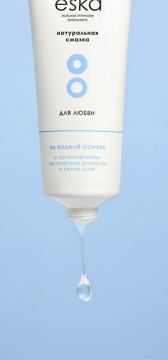 Eska - water-based lubricant, 75 ml
19,50 USD
Eska - water-based lubricant, 75 ml
19,50 USD
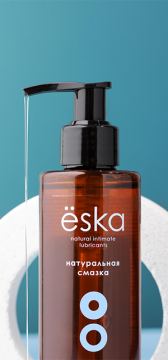 Eska - water-based lubricant, 200 ml
42,40 USD
Eska - water-based lubricant, 200 ml
42,40 USD
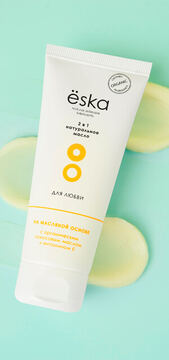 Eska - oil-based lubricant, 75 ml
23,10 USD
Eska - oil-based lubricant, 75 ml
23,10 USD
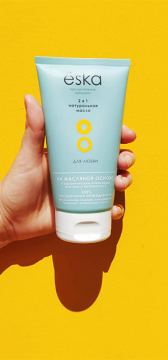 Popular
Eska - oil-based lubricant, 150 ml
38,90 USD
Popular
Eska - oil-based lubricant, 150 ml
38,90 USD
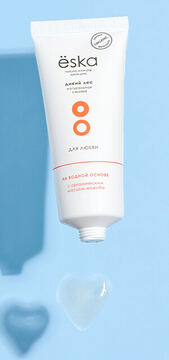 New
Eska - water-based lubricant Wild Forest, 75 ml
19,50 USD
New
Eska - water-based lubricant Wild Forest, 75 ml
19,50 USD
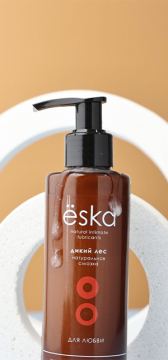 Eska - water-based lubricant Wild Forest, 200 ml
42,40 USD
Eska - water-based lubricant Wild Forest, 200 ml
42,40 USD
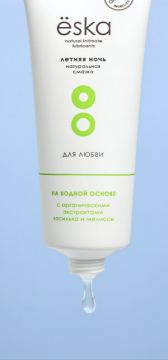 Eska - water-based lubricant Summer Night, 75 ml
19,50 USD
Eska - water-based lubricant Summer Night, 75 ml
19,50 USD
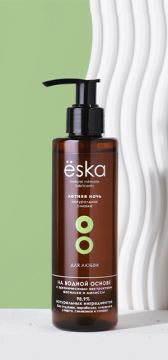 Eska - water-based lubricant Summer Night, 200 ml
42,40 USD
Eska - water-based lubricant Summer Night, 200 ml
42,40 USD
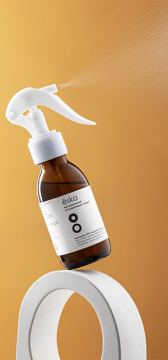 New
Eska - spray for cleaning and disinfecting sex toys
15,90 USD
New
Eska - spray for cleaning and disinfecting sex toys
15,90 USD